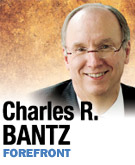Subscriber Benefit
As a subscriber you can listen to articles at work, in the car, or while you work out. Subscribe Now
 ncrease the percentage of students passing ISTEP+ in math and language arts at the third- and eighth-grade levels. Raise the percentage of high school graduates earning a Core 40 or Academic Honors diploma.
ncrease the percentage of students passing ISTEP+ in math and language arts at the third- and eighth-grade levels. Raise the percentage of high school graduates earning a Core 40 or Academic Honors diploma.
These and other benchmarks are what it will take to keep the educational pipeline full and increase the number of students who complete a college degree.
Central Indiana’s Talent Alliance has issued its first community benchmark report that identifies the key indicators that will enable our community to increase the percentage of residents with a college degree.
The Talent Alliance combines leadership, resources and data to improve educational outcomes. It does not create new programs. Rather it identifies, supports and strengthens effective practices already in place.
By adopting a common community agenda and increasing visibility for successful efforts, we can appeal for resources more effectively and ensure financial sustainability for programs that we know are working to achieve our goal of having a higher level of educational attainment for all our citizens.
Central Indiana Talent Alliance has enabled us to adopt a common agenda and measurement system so that we stay focused.
We are sharpening our focus on improving Indianapolis by pursuing the Talent Dividend. CEOs for Cities economic data indicate that raising the college attainment rate 1 percent in central Indiana would add the equivalent of $1.3 billion annually to the local economy. Imagine the enhanced quality of life we would enjoy if we could meet or exceed the Talent Dividend goal here!
To give us extra incentive, Indianapolis entered the Talent Dividend Prize competition. Announced last week, 57 cities are competing for a $1 million prize to be awarded to the city that exhibits the greatest increase in the number of postsecondary degrees granted per 1,000 population over four years. With additional support from the Central Indiana Community Foundation and the Kresge Foundation, we are determined to have Indianapolis win!
While we emphasize increasing college graduates, the Talent Alliance promotes improvement by monitoring indicators that target key transition years in students’ progress. Too many low-income children lack access to preschools and cognitively stimulating learning opportunities critical to child development.
We must develop a standard assessment instrument for kindergarten readiness and close the gaps in cognitive development that inhibit school performance. We know that youth ages 6 to 10 benefit from out-of-school experiences that support their social, academic, personal, physical and emotional development.
Can we find a way to increase the number of accessible out-of-school programs—staffed by caring, competent adults—so that these students get a better foundation in school?
As students advance into middle school and high school, what are the critical pre-college interventions that both communicate high expectations and ensure optimal academic preparation for college? Too few students in grades 9-12 take the challenging courses needed to prepare for postsecondary education, and too many drop out.
It is critical that we all help keep individuals motivated and supported to achieve the highest level of education to which they aspire. Our baseline data tell us that middle school is the fork in the road in a child’s life. It is the time when intentions and actions must merge so that students apply themselves rigorously to the academic preparation they need to succeed at the college level. Too many students fall through the cracks.
Learning what interventions work best, and when, will make us more effective as a community in supporting individuals’ aspirations. And we will all benefit as a result with a higher quality of life, a more robust economy and an engaged citizenry. Higher education is associated with higher income, better health, improved resiliency in periods of economic downturn, and increased volunteerism and philanthropy.
There’s much to be gained, and nothing to lose, in an all-out community effort to improve education in central Indiana.•
__________
Bantz, chancellor of IUPUI, chairs the executive committee of Central Indiana’s Talent Alliance. Send comments to ibjedit@ibj.com.
Please enable JavaScript to view this content.
